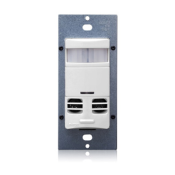404.2(C) Switch Connections
Change Summary
- Revisions clarified that a grounded conductor of the lighting circuit at switch locations shall be connected to the electronic device.
| NEC® Text |
|---|
|
404.2 Switch Connections. (1) Where conductors enter the box enclosing the switch through a raceway, provided that the raceway is large enough for all contained conductors, including a grounded conductor The grounded conductor shall be extended to any switch location as necessary and shall be connected to switching devices that require line-to-neutral voltage to operate the electronics of the switch in the standby mode and shall meet the requirements of 404.22. Exception: The connection requirement shall become effective on January 1, 2020. It shall not apply to replacement or retrofit switches installed in locations prior to local adoption of 404.2(C) and where the grounded conductor cannot be extended without removing finish materials. The number of electronic lighting control switches on a branch circuit shall not exceed five, and the number connected to any feeder on the load side of a system or main bonding jumper shall not exceed 25. For the purpose of this exception, a neutral busbar, in compliance with 200.2(B) and to which a main or system bonding jumper is connected shall not be limited as to the number of electronic lighting control switches connected. Informational Note: The provision for a (future) grounded conductor is to complete a circuit path for electronic lighting control devices. Copyright© 2016 National Fire Protection Association |
Expert Analysis
The concept from the beginning for requiring the presence and use of the grounded conductor at switch locations was due primarily to the increased demand for electronic lighting control devices (such as an occupancy sensor) which require standby current to maintain a ready state of detection, even in the “off” position. When the grounded conductor is not present, installers have been known to employ the equipment grounding conductor for the standby current of these control devices.
The latest attempt to eliminate this intentionally introduced current onto the equipment grounding conductor resulted in further revisions to 404.2(C). One of the first changes was in response to the indication that 404.2(C) required a grounding conductor to be “present” at switch locations, but did not demand that the supplied grounded conductor be used or “connected” to the switching device. To that end, the first sentence at 404.2(C) was revised to state that the grounded circuit conductor be “installed” at the switch locations rather than simply “provided.” New more direct text was added further down in the requirement to state, “the grounded conductor shall be extended to any switch location as necessary and shall be connected to switching devices that require line-toneutral voltage to operate the electronics of the switch in the standby mode.”
This requirement references 404.22, which is a new section under Part II of Article 404 for the “Construction Specifications” for a switching device. This is largely a manufacturer’s requirement and is covered in the next article in this Pocket Guide.
The previously discussed grounded conductor connection requirement has an added exception that will delay enforcement until January 1, 2020. This exception further relieves this connection requirement from “replacement or retrofit switches installed in locations prior to local adoption of 404.2(C) and where the grounded conductor cannot be extended without removing finish materials.” This exception will allow some continuation of older designs, which is warranted for replacement or retrofit installations in existing or previous applications.
This new exception goes on to limit the actual number of electronic lighting control switches on a branch circuit to “not exceed 5,” and the number connected to any feeder on the load side of a system or main bonding jumper to “not exceed 25.” This limitation is a result of simple mathematics- as more devices are added to the branch circuit leaking current to the neutral, it will start to add up and become a hazard.
 Leviton offers a wide selection of occupancy and vacancy sensors, commonly referred to as “motion sensors” or “motion light sensors” for commercial and residential applications. Neutral required and non-neutral required devices are available to meet this Code requirement. These state-of-the-art devices use passive infrared, ultrasonic or a combined multi-sensing technology. From wall and ceiling mount to wall switch and wireless, Leviton motion sensors enhance convenience, security and provide smart energy saving solutions for both indoor and outdoor use. Leviton Occupancy Sensors and Vacancy Sensors meet requirements for Title 24, ASHRAE 90.1 and IECC.
Leviton offers a wide selection of occupancy and vacancy sensors, commonly referred to as “motion sensors” or “motion light sensors” for commercial and residential applications. Neutral required and non-neutral required devices are available to meet this Code requirement. These state-of-the-art devices use passive infrared, ultrasonic or a combined multi-sensing technology. From wall and ceiling mount to wall switch and wireless, Leviton motion sensors enhance convenience, security and provide smart energy saving solutions for both indoor and outdoor use. Leviton Occupancy Sensors and Vacancy Sensors meet requirements for Title 24, ASHRAE 90.1 and IECC.









